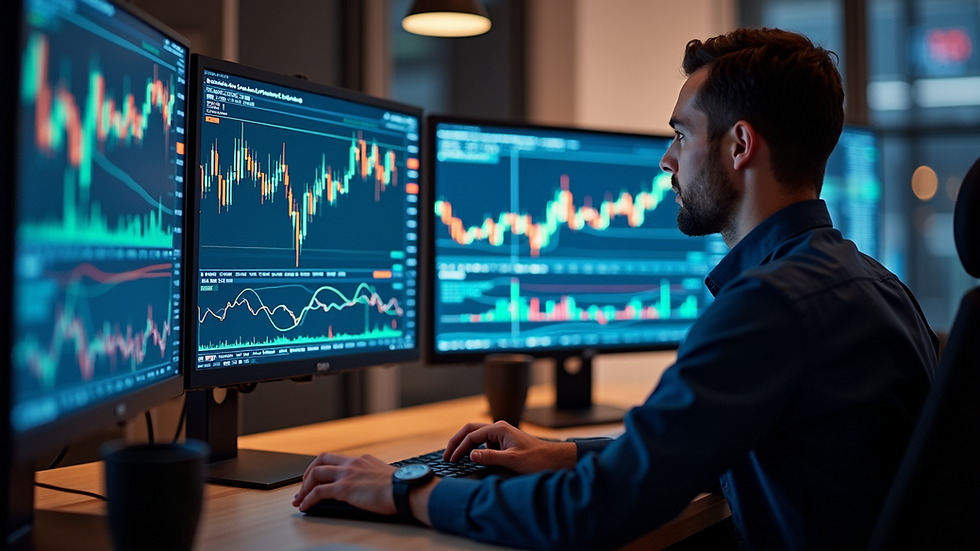Forex Trading Basics and Essentials
- Forex Fire Members

- Nov 3
- 4 min read
Diving into the world of forex trading can feel like stepping into a vast, fast-moving river. It’s exciting, full of opportunities, but also requires skill and knowledge to navigate safely. I’ve been there, and I know how overwhelming it can be at first. But don’t worry! With the right basics and essentials, you can start your journey confidently and build a strong foundation for success.
Let’s break down the core concepts and practical tips you need to get started and thrive in this dynamic market.
Understanding Forex Trading Basics
Forex trading is all about exchanging one currency for another. Think of it as swapping pounds for euros or dollars for yen. The goal? To profit from changes in exchange rates. It’s the largest financial market in the world, with trillions of pounds traded daily. That means plenty of opportunities for traders like us!
Here’s what you need to know:
Currency Pairs: Forex is always traded in pairs, like GBP/USD or EUR/JPY. The first currency is the base, and the second is the quote. When you buy a pair, you’re buying the base currency and selling the quote currency.
Pips and Lots: A pip is the smallest price move in a currency pair, usually 0.0001. Lots are the size of your trade. A standard lot is 100,000 units of the base currency, but you can trade mini or micro lots too.
Leverage: This lets you control a large position with a small amount of money. It’s powerful but risky. Use it wisely!
Spread: The difference between the buy and sell price. Lower spreads mean lower trading costs.
Mastering these basics is your first step. Once you understand them, you can start exploring strategies and tools to improve your trading.

Essential Tools and Platforms for Trading
To trade effectively, you need the right tools. A reliable trading platform is your command centre. It lets you analyse markets, place trades, and manage risk. Popular platforms like MetaTrader 4 and 5 offer user-friendly interfaces and powerful features.
Here’s what to look for in a platform:
Real-time Data: Accurate, up-to-the-second price information.
Charting Tools: Customisable charts with indicators to spot trends.
Order Types: Market, limit, stop-loss, and take-profit orders to control your trades.
Mobile Access: Trade on the go with apps for your phone or tablet.
Besides platforms, consider these essentials:
Economic Calendar: Stay updated on key events that impact currencies.
News Feeds: Follow financial news to understand market sentiment.
Demo Account: Practice trading without risking real money.
Using these tools will help you make informed decisions and build confidence.
How to Develop a Winning Trading Strategy
A solid strategy is your roadmap in forex trading. Without it, you’re just guessing. I recommend starting with a simple approach and refining it over time.
Here’s a step-by-step guide:
Choose Your Style: Day trading, swing trading, or position trading. Each has different timeframes and risk levels.
Identify Entry and Exit Points: Use technical analysis like support and resistance levels, moving averages, or candlestick patterns.
Set Risk Management Rules: Decide how much you’re willing to risk per trade (usually 1-2% of your capital).
Backtest Your Strategy: Test it on historical data to see how it performs.
Keep a Trading Journal: Record your trades, reasons, and outcomes to learn from mistakes and successes.
Remember, no strategy is perfect. The key is consistency and discipline.

Managing Risk Like a Pro
Risk management is the secret sauce of successful trading. It protects your capital and keeps you in the game longer. Here’s how I manage risk:
Use Stop-Loss Orders: Automatically close a trade if it moves against you beyond a set point.
Limit Leverage: High leverage can amplify losses. Start small and increase only as you gain experience.
Diversify Trades: Don’t put all your money into one currency pair.
Control Emotions: Fear and greed can cloud judgment. Stick to your plan and avoid impulsive decisions.
By managing risk effectively, you can survive losing streaks and capitalise on winning trades.
Continuous Learning and Community Support
Forex trading is a journey, not a destination. Markets evolve, and so should your skills. I always recommend ongoing education and connecting with other traders.
Take Courses: Structured learning helps you grasp complex concepts quickly. Check out forex trading courses tailored for beginners and intermediates.
Join Forums and Groups: Share ideas, ask questions, and get feedback.
Follow Expert Traders: Learn from their strategies and mistakes.
Stay Updated: Markets react to global events. Keep your knowledge fresh.
Building a supportive community around your trading can boost motivation and accelerate growth.
Your Next Steps in Forex Trading
Now that you’ve got the basics and essentials down, it’s time to take action. Start small, practice with a demo account, and gradually move to live trading. Remember, patience and persistence pay off.
Here’s a quick checklist to get you moving:
Open a demo account on a trusted platform.
Learn to read charts and use technical indicators.
Develop a simple trading plan with clear rules.
Practice risk management on every trade.
Join a community or take a course to deepen your knowledge.
Trading forex is a skill you build over time. Stay curious, stay disciplined, and enjoy the journey!
Ready to take your trading to the next level? Explore expert guidance and courses designed to help you trade profitably and confidently. Your success story starts here!








Comments